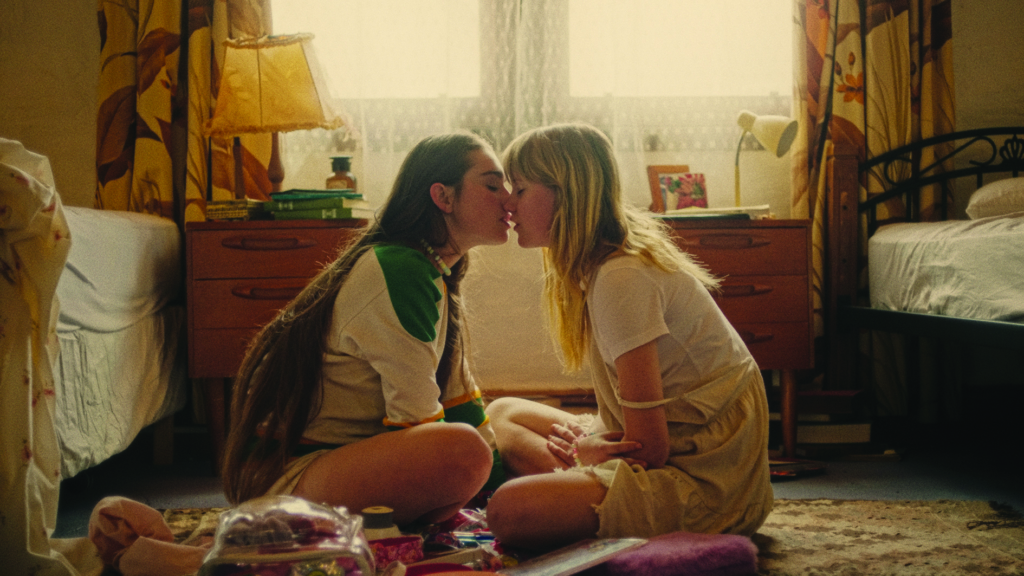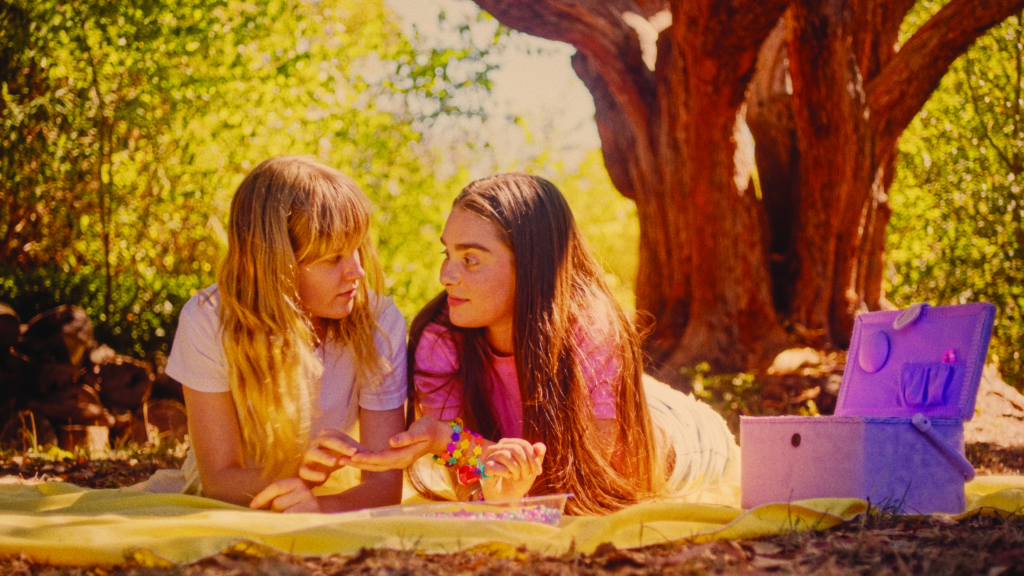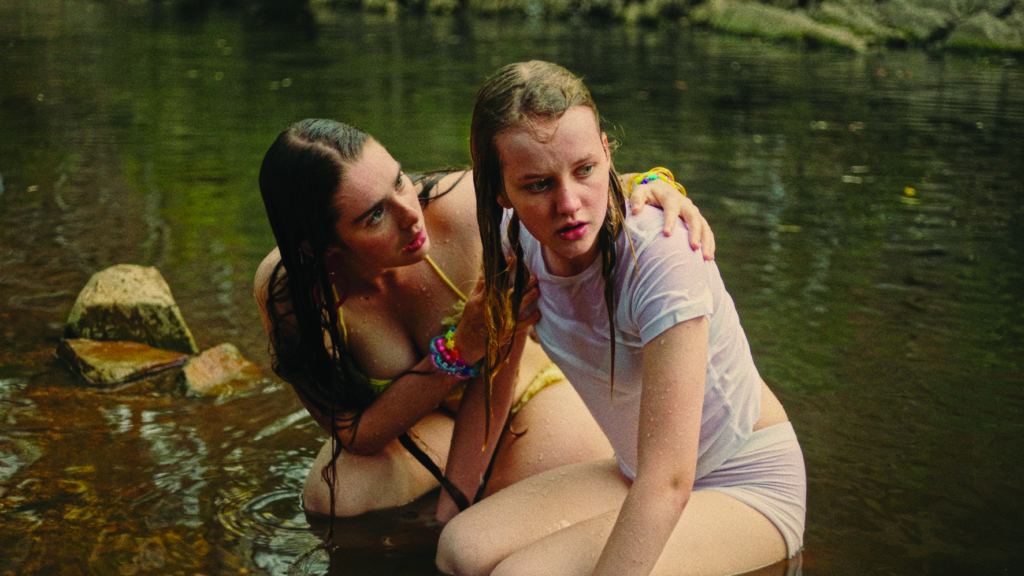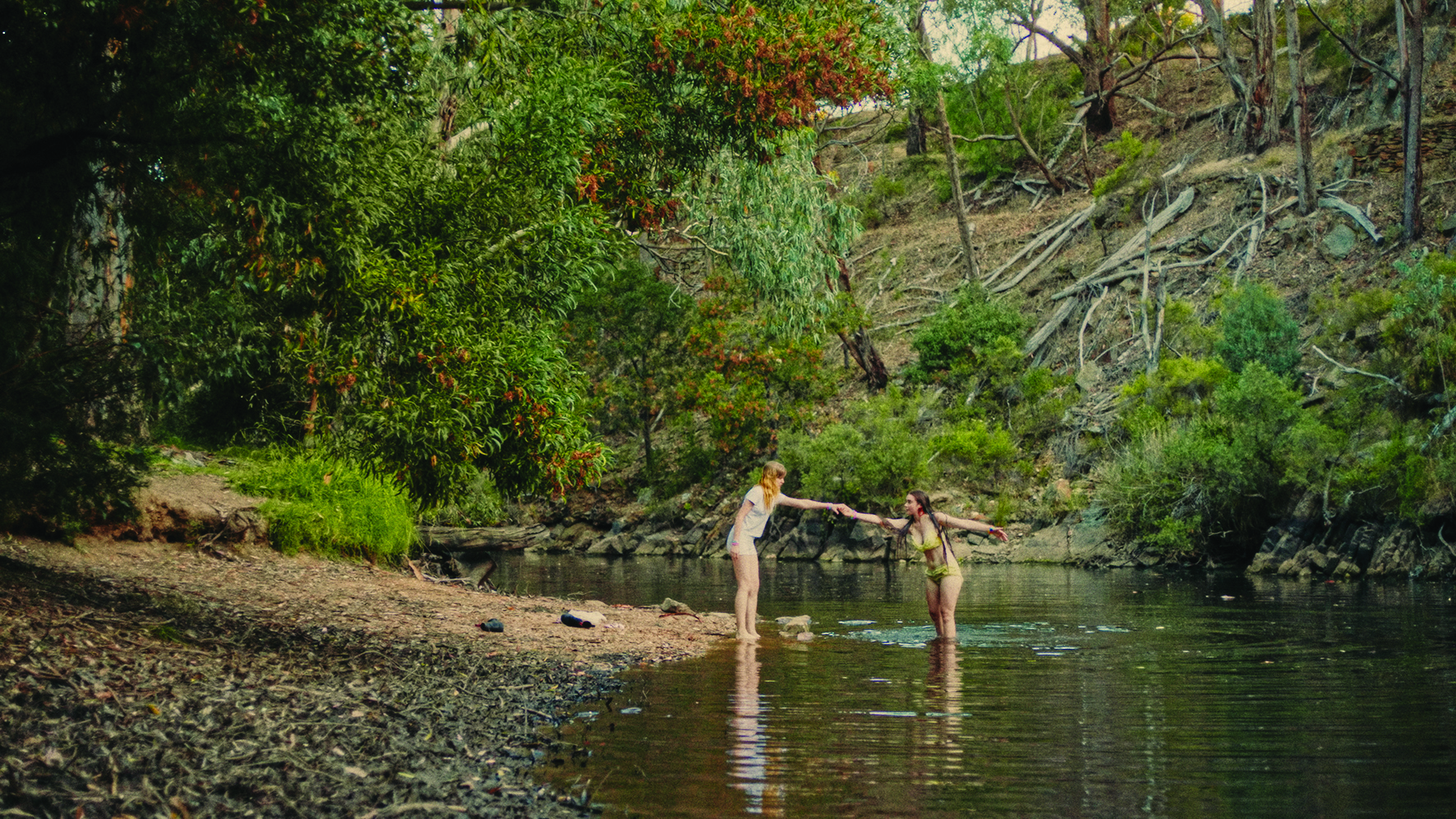My First Summer (Katie Found, 2020) is a dream. It’s part lesbian fantasy, part nostalgia for childhood, part woozy mixture of the two, overlapping in beautiful, uncomfortable ways – sugary nostalgia with a darker (liquorice?) centre. Like in most dreams, time in this film is off kilter but still makes sense. It’s both suspended and fluid, more honey than water. Its heroes are the same, happily trapped in the amber of childhood while that same sap drips over legs and torsos, turning girls into women. This is a coming-of-age film that takes that particular passage and turns it back on itself. It’s a beguiling and productive proposition that works through a cross-section of trauma, romance and queerness. It’s a realist narrative that feels like a mirage.
The film is a love story between two young women, both lost in different ways. Once they find each other, they carve out a luminescent refuge for themselves, far from the angry, alien worlds of everyday existence and the institutions that prop it up. Sixteen-year-old Grace (Maiah Stewardson) is an outsider in a small Australian town. She rides around dirt roads in a tutu and Blundstones, content by herself. On one of her wanderings, she witnesses a woman walking slowly, deliberately into a lake, taking a young girl (her daughter, perhaps) with her. The woman never surfaces, but the younger thrashes, clambers back onto the bank and runs into the woods. Grace returns to the scene and the property nearby a day later to find the girl, Claudia (Markella Kavenagh), frightened and hiding with her dog. After some coaxing from Grace, a bond begins to form between them. Claudia is Grace’s secret, and she vows to take care of her while maintaining the hermitage begun by Claudia’s troubled, now dead, mother. No-one apart from Grace knows Claudia exists. She could be a figment of a lonely girl’s imagination – and, for much of the movie, she kind of is.
Like Claudia, Grace’s existence is precarious, but in a different way. She is the school weirdo who, by her own admission, nobody likes or really notices. At home, archetypally mean and neglectful parental figures care little about what she does while off in the world, and even less when she is home. When she is alone with him, her stepfather’s tone becomes overly familiar, suggestive, sinister. Claudia, along with the property she lives on, gives Grace an escape hatch. It’s logical, then, that these two almost imaginary figures operate in a dreamlike space.
The film’s golden, perfect light (thanks to some brilliant work by DOP Matthew Chuang) is a key character in My First Summer. During scenes at the property, where most of the film takes shape, the glow keeps the viewer snuggled up and dozy. It also gives the Australian bush that surrounds the little homestead a timelessness that feeds into the dream. The same light bouncing off brown skin, hands and watermelon-flavoured lips makes this dozing a bit more handsy, a bit more randy.

The intimacy the two develop is quick and easy. Trust and affection between them appears soon after Grace makes her discovery. The narrative quickly tumbles into a series of increasingly sensual games amid introductions of first tastings of strawberry milk, lolly bracelets, flavoured lip gloss – the aesthetics of their romance appear plucked from little girls’ daydreams. They pin pop images from magazines onto bedroom walls. They hold a tea-party-esque ritual for their first taste of coffee. They make friendship bracelets for each other. They play kissing games under the cubby-like branches of a fruit tree.
The iconography of childhood – and, by association, innocence and naivety – sits uncomfortably in this space, depending on the viewer’s willingness to be carried away into the dream-space created. Watching a sixteen-year-old girl with a tutu pulled up over her tracksuit by wrists covered in plastic beads is unnerving. Watching that same sixteen-year-old have an edible necklace eaten off her neck during a ravenous make-out session is both disturbing and delectable – not perverse, as such, but nudging towards the anarchic.
The iconography of childhood – and, by association, innocence and naivety – sits uncomfortably in this space, depending on the viewer’s willingness to be carried away into the dream-space created.
There could be something problematic, even patronising, about couching this desire in babyish play. It threatens to take the girls’ desire as whimsy, a ‘phase’ – the watchword for homophobic parentage – from which both will wake. Indeed, Found creates a world shot through with a fragility that renders the relationship resolutely finite, and the film could be read as a contemporary replacement for the tragedy that often (albeit more so in decades past) befalls queer characters in cinema. But the iconographies of childhood are so present, so blunt in their depiction and repetition, that something more is clearly going on.

From experience and observation, at sixteen, girls’ ‘play’ is typically about adulthood. It’s about reaching outside, beyond and past childlike fantasy, and imagining oneself at university, pubs or nightclubs. It’s about being older, more autonomous, sexually free – getting a pay cheque of one’s own. In the predominant heteronormative mould of mainstream culture and imagination, this ‘adulting’ includes career, marriage and children, and functions as a neat, linear trajectory. The politically queer body, on the other hand, rejects these prescriptions and takes the opportunity to reimagine ways of being that operate outside this framework. Grace and Claudia are doing something similar; as such, My First Summer operates in ‘queer time’.
‘Queer time’, as a concept in queer theory, was first introduced by scholar Jack Halberstam in 2005 to describe the inevitable ‘queering’ of societal expectations and accompanying time stamps of life, love and productivity. As Halberstam puts it, queer experiences of time and place develop ‘in opposition to the institutions of family, heterosexuality, and reproduction’. Queerness itself, he argues, can be thought of as ‘an outcome of strange temporalities, imaginative life schedules, and eccentric economic practices’.[1]Published under the author’s alternative name, Judith Halberstam. See Halberstam, In a Queer Time and Place: Transgender Bodies, Subcultural Lives, New York University Press, New York, 2005, p. 1. Major queer life milestones – including coming out, gender transitioning, procreation and first sexual relationships – tend to operate outside the parameters of the heteronormative narratives of Hollywood cinema, traditional fairytales, sex education and religious instruction. Queer ways of life are (not always, but very often) oppositional – and, thus, revolutionary.
My First Summer is a coming-of-age film so far as it’s about teenage self-discovery. But while that concept is conceived as movement through time, Found’s film takes the girls away from rather than towards the obligations and institutions of adulthood. The film’s dream-space is a queer utopia: Grace becomes Claudia’s parental figure and lover, guardian and breadwinner; once inside the fence that marks the property line, they don’t have to deal with the outside world – the small-town sneers, or systemic obstacles of school and parents and the Department of Social Services – or even have to ‘come out’. They just are. The material conditions of their seclusion allow something beautiful to take shape between them.

The queer coming-of-age film has a healthy lineage globally, particularly in recent years with the success of works like Call Me by Your Name (Luca Guadagnino, 2017), The Miseducation of Cameron Post (Desiree Akhavan, 2018) and Raw (Julia Ducournau, 2016). Australian cinema has also had its share of queer classics – from The Adventures of Priscilla, Queen of the Desert (Stephan Elliot, 1994) to Holding the Man (Neil Armfield, 2015) – but, historically, those that have received distribution and notoriety have been, by and large, about cis men. Bring up any ‘best of’ list for Australian queer cinema and the majority of films in the list will likely be about male desire.[2]See, for example, Paul Merrill, ‘The 15 Greatest Australian LGBTQI Films of All Time’, NME, 2 September 2020, <https://www.nme.com/en_au/features/best-australian-lgbtqi-films-2743044>, accessed 4 June 2021. Australian storytellers, and those who fund them, are still a bit coy about sexual desire between women: it’s a place of mystery; it happens off screen; it’s not seen like sex between men is seen.
This is not altogether surprising considering the low bar of the Bechdel test (in which a pass is given to films solely for including two women talking to each other about something other than men) is still a handy instrument by which to measure mainstream cinema.[3]See Radhika Seth, ‘Why Are Films Failing the Bechdel Test When TV Has Progressed?’, Vogue, 15 July 2020, <https://www.vogue.co.uk/arts-and-lifestyle/article/the-bechdel-test>, accessed 21 May 2021. Screen Australia’s Gender Matters program recently reported wins in terms of increased representation by women in key creative roles in the Australian film industry; it also found, however, that women were directing a depressing 27 per cent of features released in 2018 and 2019. Their goal for the next reporting period (2019/20 – 2021/22) is to have 50 per cent of representation in key creative roles.[4]‘Screen Australia Exceeds Gender Matters Target and Announces New KPI’, media release, Screen Australia, 21 August 2019, <https://www.screenaustralia.gov.au/sa/media-centre/news/2019/08-21-gender-matters-target-exceeded-new-kpi>, accessed 21 May 2021.
Until parity is reached, a minority of stories centring women – and far fewer still revolving around queer women – is an inevitability. This is consistent with the historical invisibility of lesbian desire, an idea that Celine Sciamma’s Portrait of a Lady on Fire (2019), for instance, puts at its bewitching heart. Visibility is important, obviously, and it’s not much to ask. But to the outside world, the girls in My First Summer are invisible; it is the condition on which their romance depends. Invisibility, here, is both liberator and captor: it makes the love they share more urgent, exploratory and rich than it would be without being both hidden and finite.

Halberstam cites the end of the twentieth century as the period from which queer time ‘emerges most spectacularly […] from within those gay communities whose horizons of possibility have been severely diminished by the AIDS epidemic’.[5]Halberstam, op. cit., p. 2. He continues:
In his memoir of his lover’s death from AIDS, poet Mark Doty writes: ‘All my life I’ve lived with a future which constantly diminishes but never vanishes’ […] The constantly diminishing future creates a new emphasis on the here, the present, the now, and while the threat of no future hovers overhead like a storm cloud, the urgency of being also expands the potential of the moment and, as Doty explores, squeezes new possibilities out of the time at hand.[6]ibid.
A magnified and rarefied present is a place: a place of refuge and healing and possibility and rebellion. It’s the same for Grace and Claudia.
In preparing for this piece, I wrote to Found to ask about the disconnect between the girls’ ages and the aesthetics of their play in My First Summer. She confirms that the children’s games and toys are used in the film to point towards Grace’s trauma and her rejection of adulthood. ‘I imagine that those objects (Lip Smackers, glitter eyeshadow, bracelets) brought her great comfort and joy in her early years before the adult world started to encroach,’ she explains.
Grace introduces these delicacies from the outside world to Claudia, one by one. These girly gifts (even the milk is pink) become talismans of safety. The ‘simple pleasures’ of girlhood are represented as being both pure – untainted by adulthood – and utterly sensual. The two reinvent femininity, then have a big play under the garden hose. Once the outside world inevitably crashes in with the clumsy barrage of police and social services, the film abruptly ends. Found is not interested in the afterwards: in the integration of Claudia into ‘normal society’, or in whether or not the romance will survive in air that isn’t golden or sugary. It’s enough to know that this almost imaginary time has an expiry date, but it’s equally important that the girls’ new, imperfect reality is given the (very little) screen time it deserves.
https://www.myfirstsummer.com/
Endnotes
| 1 | Published under the author’s alternative name, Judith Halberstam. See Halberstam, In a Queer Time and Place: Transgender Bodies, Subcultural Lives, New York University Press, New York, 2005, p. 1. |
|---|---|
| 2 | See, for example, Paul Merrill, ‘The 15 Greatest Australian LGBTQI Films of All Time’, NME, 2 September 2020, <https://www.nme.com/en_au/features/best-australian-lgbtqi-films-2743044>, accessed 4 June 2021. |
| 3 | See Radhika Seth, ‘Why Are Films Failing the Bechdel Test When TV Has Progressed?’, Vogue, 15 July 2020, <https://www.vogue.co.uk/arts-and-lifestyle/article/the-bechdel-test>, accessed 21 May 2021. |
| 4 | ‘Screen Australia Exceeds Gender Matters Target and Announces New KPI’, media release, Screen Australia, 21 August 2019, <https://www.screenaustralia.gov.au/sa/media-centre/news/2019/08-21-gender-matters-target-exceeded-new-kpi>, accessed 21 May 2021. |
| 5 | Halberstam, op. cit., p. 2. |
| 6 | ibid. |





